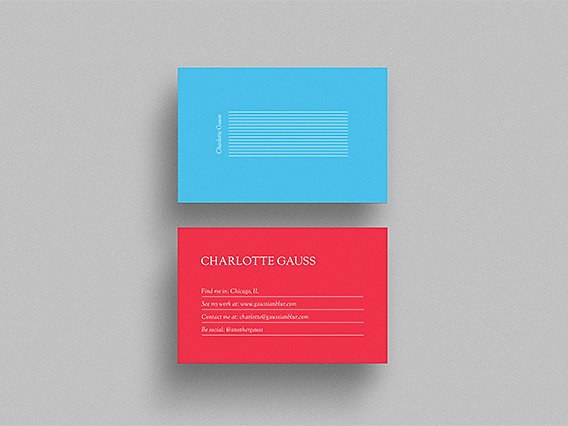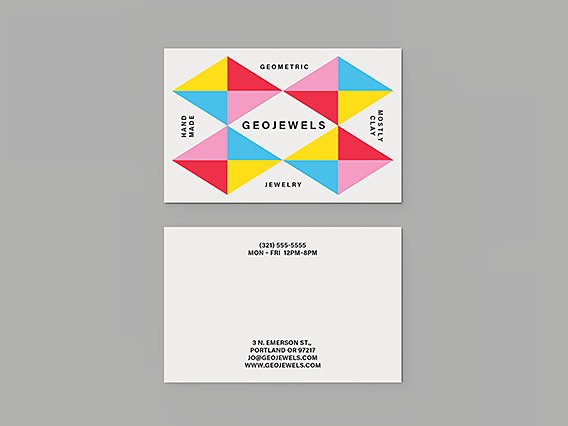Make better connections with a student business card.
Create your own business card to grow your personal brand, aid in your job search, and help you take your first steps into the professional world.

Yes, college students need business cards too.
Potential employers meet and correspond with dozens, sometimes hundreds, of qualified candidates when they need to fill a role. It’s essential that you stand out from the crowd, and a memorable business card design can help you make a good first impression. It also ensures that if you do make a lasting impression, the person you wowed has your information and can get in touch.
With Adobe InDesign business card templates, you don’t need to be a graphic design major to create a card that will impress recruiters at networking events or when shared digitally.
Explore business card templates
Make yourself easy to contact.
While a good resume or LinkedIn profile showcases your work experience and credentials, a good business card clearly lists all the ways that someone can reach out to you. You always want to make it easy for people to connect, so contact info is your business card’s most important element. Here are the details you’ll want to include:

- Name: Make sure your name is prominently featured on your card. You don’t want a crucial piece of information to be a challenge to find.
- Job title: While you may not have a current role at a company, make sure to mention your industry or field, like engineer, writer, accounting specialist, graphic designer, data scientist, photographer, etc. That will help someone remember who you are and why they have your card. Students can also list their college or school, expected graduation year, and major(s) and minor(s). Be careful not to use any college or school logos that might be copyrighted or make it appear you are an employee rather than a student.
- Contact information: List all the ways that people can reach you. Your phone number and email address are must-haves on any business card. Make sure you list only email addresses you use regularly. You don’t want to send someone to a channel you rarely check and miss a good opportunity. To that end, make sure to use a personal or professional email address that features your name, not a funny nickname. Do not use a university address that may phase out after graduation. Information like your home address or grade point average can be omitted. They are unnecessary for a card where you must save space for the most important contact information.
- Website: If you have a portfolio site or a professional blog that showcases your work, add it to your business card. This gives people you network with a direct line to view your work.
- Social media: If you have a professional Twitter handle, Instagram account, or YouTube, Facebook, or LinkedIn page, you can feature one or two on your card. Don’t overload the card with URLs. A readable, simple design is better than a crowded one.
- Professional photo: Some business cards feature a professional headshot. This can help people connect your name to your face.

Quality control is key.
To create an impactful business card that represents you well, take these considerations into account when designing and printing your cards.
- Font style and size: While stylish font choices may help you stand out, legibility should be the number one priority. Font size is an important part of readability too. If you need to make your font extremely small in order to fit all your info onto the card, that’s a sign you need to prioritize which info you really need so you can increase the font size.
- Color choices: The color palette you choose can help make your business card distinct, but make sure legibility reigns. You don’t want bright yellow neons that are hard to read on a white background. Also, color choices should reflect your specialization and desired field of work. Bright colors that pop could be perfect for an aspiring artist, but might not be a great fit for a recent accounting grad.
- Paper quality: A flimsy card can get bent, folded, and ripped before it’s quickly discarded. Do a test print on a few card stocks to find one with the right sturdiness and weight. It might also be worth investing in a card holder to keep your business cards crisp. Folded corners on a card you just fished out of your pocket are a small drawback that’s easy to avoid.
Jump-start your business card with InDesign templates.
It’s easy to put together a slick business card with InDesign templates from Adobe Stock.


- Simple and classic: Keep it professional and direct with this minimalist design.
- Stark and stylish: Add a little spice with this well-designed and easy-to-read black-and-white card.
- A touch of color: These minimalist designs feature subtle colors to help your card make a professional impression.
- Colorful and eye-catching: Want to showcase some flair? This unique card features color pops that stand out.
- Imagery that entices: Get in all the necessary information alongside a photo or piece of art that will intrigue and delight potential employers.
Make every first impression a win.
Whether you choose a template or opt to build your card from scratch, tutorials in InDesign and those available online can help job seekers like you quickly design a business card that turns networking into new work. And with the other apps in Adobe Creative Cloud, business card designs can be adapted for online use with animated logos and more features great for websites, in emails, and on social media.

Shaping the future. One student at a time.
Adobe Ambassadors and campus clubs make it easier to get started with Creative Cloud.
More great benefits.

Get the apps on all your devices.

Learn at your own pace.

Access the latest version of all the apps.
Students get all apps for the price of a single app.
Creative Cloud for students and teachers
Get 20+ apps, including Photoshop, Illustrator, and lnDesign. Save over 60%.
US$ 20.99/mo* US$ 60.89/mo
For the first year, then after that.
Check eligibility